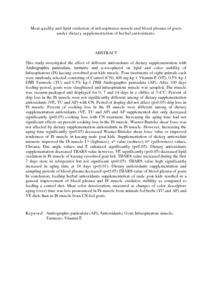Citation
Karami, M and Alimon, Abdul Razak and Sazili, Awis Qurni and Goh, Yong Meng
(2010)
Meat quality and lipid oxidation of infraspinatus muscle and blood plasma of goats under dietary supplementation of herbal antioxidants.
Journal of Animal and Veterinary Advances, 9 (24).
pp. 3039-3047.
ISSN 1680-5593
Abstract
This study investigated the effect of different antioxidants of dietary supplementation with Andrographis paniculata, turmeric and α-tocopherol on lipid and color stability of Infraspinatous (IS) kacang crossbred goat kids muscle. Four treatments of eight animals each were randomly selected consisting of Control (CN), 400 mg kg-1 Vitamin E (VE), 0.5% kg-1 DMI Turmeric (TU) and 0.5% kg-1 DMI Andrographis paniculata (AP). After 100 days feeding period, goats were slaughtered and infraspinatous muscle was sampled. The muscle was vacuum-packaged and displayed for 0, 7 and 14 days in a chiller at 3-4°C. Percent of drip loss in the IS muscle were not significantly different among of dietary supplementation antioxidants (VE, TU and AP) with CN. Period of display did not affect (p>0.05) drip loss in IS muscle. Percent of cooking loss in the IS muscle were different among of dietary supplementation antioxidants (VE, TU and AP) and AP supplemented diet only decreased significantly (p<0.05) cooking loss with CN treatment. Increasing the aging time had not significant effects on percent cooking loss in the IS muscle. Warner-Bratzler shear force was not affected by dietary supplementation antioxidants in IS muscle. However, Increasing the aging time significantly (p<0.05) decreased Warner-Bratzler shear force value or improved tenderness of IS muscle in kacang male goat kids. Supplementation of dietary antioxidant turmeric improved the IS muscle L* (lightness), a* value (redness), b* (yellowness) values, Chroma, Hue angle values and E enhanced significantly (p<0.05). Dietary antioxidants supplementation decreased TBARS value however, VE significantly (p<0.05) decreased lipid oxidation in IS muscle of kacang crossbred goat kid. TBARS value increased during the first 7 days store in refrigerator but not significant (p>0.05). TBARS value high significantly increased in aging time at 14 days (p<0.01). Dietary antioxidants supplementation and sampling periods of blood plasma decreased (p<0.05) TBARS value of blood plasma of goats. In conclusion, feeding herbal antioxidants supplementation of male goat kids resulted in a general improvement of blood plasma and IS muscle oxidative stability as compared to feeding a control diet. Meat color deterioration, measured as changes of color descriptors aging (over) time was less pronounced in IS muscle from animals fed herbs (TU and AP) and VE diets than in IS muscle from CN-fed goats.
Download File
![[img]](http://psasir.upm.edu.my/15579/1.hassmallThumbnailVersion/Meat%20quality%20and%20lipid%20oxidation%20of%20infraspinatus%20muscle%20and%20blood%20plasma%20of%20goats%20under%20dietary%20supplementation%20of%20herbal%20antioxidants.pdf)  Preview |
|
PDF (Abstract)
Meat quality and lipid oxidation of infraspinatus muscle and blood plasma of goats under dietary supplementation of herbal antioxidants.pdf
Download (187kB)
| Preview
|
|
Additional Metadata
Actions (login required)
 |
View Item |

